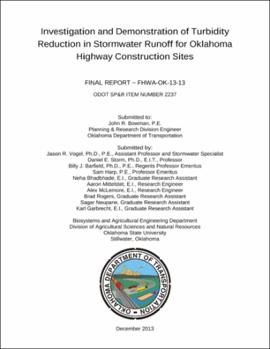| dc.creator | Vogel, Jason | |
| dc.creator | Storm, Daniel | |
| dc.creator | Barfield, Billy | |
| dc.creator | Harp, Sam | |
| dc.creator | Bhadbhade, Neha | |
| dc.creator | Mittelstet, Aaron | |
| dc.creator | McLemore, alex | |
| dc.creator | Rogers, Brad | |
| dc.creator | Neupane, Sagar | |
| dc.creator | Garbrecht, Karl | |
| dc.date.accessioned | 2018-03-01T20:50:10Z | |
| dc.date.available | 2018-03-01T20:50:10Z | |
| dc.date.issued | 2013-12 | |
| dc.identifier.govdoc | FHWA-OK-13-13 | |
| dc.identifier.other | Oklahoma Department of Transportation State Planning and Research item number 2237 | |
| dc.identifier.uri | https://hdl.handle.net/11244/54453 | |
| dc.description.abstract | The Environmental protection Agency (USEPA) has issued new requirements on the construction industry to control the discharge of pollutants from the sites. The construction effluent guidelines or ELG’s require construction sites to reduce the pollutant discharge to ‘maximum extent practicable’ and comply with the Clean Water Act. Sediment is the primary pollutant in a construction site effluent runoff. It is mainly composed of large amounts of fine silt, clay and colloidal particles. These particles have low settling velocities and remain in suspension for long durations and therefore cannot be trapped effectively in conventional BMP’s like detention ponds, grass lined channels, sedimentation basins that rely on gravity for settling. The trapping efficiencies of the particles can be enhanced by flocculation, where addition of the flocculant to the sediment discharge would bind multiple particles together, increasing them in size and increasing the settling velocity. Construction sites often experience space restrictions and therefore a modular sediment trapping system based on flocculation would require much less space compared to a settling pond especially in those regions which have high clay content in their soil, which is commonly found in state of Oklahoma. The following report presents the improved design for our passive flocculent and mixing devices. The report also includes all the experimental data collected with the flume experiments performed on the five soils from the state of Oklahoma namely Port A and Port B, Kamie B, Stephenville B and Norge B soils. The values of the flocculation constants associated with each soil are presented. Additionally, field tests on a field with Port soils are presented | |
| dc.format.extent | 439 pages | |
| dc.format.extent | 17,826,044 bytes | |
| dc.format.medium | application.pdf | |
| dc.language | en_US | |
| dc.relation.ispartofseries | No | |
| dc.relation.requires | Adobe Acrobat Reader | |
| dc.relation.uri | https://ntlrepository.blob.core.windows.net/lib/60000/60300/60315/FY13_2237_Vogel_FinalReport.pdf | |
| dc.title | Investigation and Demonstration of Turbidity Reduction in Stormwater Runoff for Oklahoma Highway Construction Sites (FHWA-OK-13-13 2237) | |
| dc.type | Technical Report | |
| dc.description.version | Final report, October 2011-December 2013 | |
| dc.description.peerreview | No | |
| dc.type.material | text | |
| dc.subject.keywords | Flocculation | |
| dc.subject.keywords | turbidity | |
| dc.subject.keywords | sediment | |
| dc.contributor.sponsor | Oklahoma Department of Transportation. Materials and Research Division. Office of Research & Implementation | |
